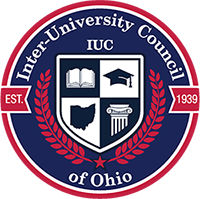Founding Institutions and Principles
In 1938, the presidents of Bowling Green State University, Kent State University and Ohio University joined Miami University and Ohio State University in a mutual protective association on behalf of all five state universities. The Inter-University Council (IUC) came into being in 1939 in large measure to protect the long-term interests of all against the potential of an over earnest Governor from advancing the interests of the state university located in his home community.
- Wilberforce University, as a state-aided institution, became an IUC member in 1948. In 1951, Central State College was created as a separate full-fledged institution split off from and replacing Wilberforce at IUC. (As other state universities were created, they were invited to join IUC.)
- The president and a member of the board of trustees represented the member institutions with IUC. The chief fiscal officers from each institution often were invited to attend as resources to Council members and contributed to the discussions. The chair of the Council was held for a one-year term by a president (who had been president for at least two years) in alphabetical order of the institutions.
- The five founding campuses initially focused on three areas of commitment:
- To recognize the exclusive mission of Ohio State to award the doctor’s degree in graduate study
- To present to the administration and legislature an agreed upon position of operating and capital needs of all five institutions and to defend these in concert.
- To cooperate in all legislation and other public interests concerning the state universities.
Budget Role
- The Council was ordinarily convened around the budget process and cycle. During this time, Council members would discuss their respective needs and the prospects for increasing the appropriations over current levels. Once agreement was reached on a total appropriation amount to request, the chair was delegated authority to begin negotiations with the Governor’s office on behalf of all institutions.
- These negotiations were conducted with the State Director of Finance. Typically, the chair of IUC would insist that the state universities needed an increased appropriation and the state budget director would counter that state revenues were limited and that an increase would be difficult to obtain.
- Once the appropriation for higher education was set, the Council members met to decide how the appropriations would be distributed among campuses. Generally the distribution corresponded to enrollments, with Ohio State receiving something more because of its doctoral work and medical school, and Central State receiving more than its proportion because of its small size. It was left for Ohio State to separately negotiate appropriations for its agricultural extension service and experiment station, and for the teaching hospitals.
- From 1939 through 1963, the administration accepted IUC’s recommendation for the distribution of higher education’s total appropriation among members. Governors and legislatures seem to have readily accepted IUC’s proposed distribution to avoid bitter political battles that would be precipitated if they determined the relative entitlement or needs of each state university.
- It was observed that the legislators from no one part of the state were sufficiently numerous or influential to dominate legislative decision making and favor one particular institution. Despite its large size, Ohio State could not dominate the politics of Ohio because legislators from Cincinnati, Dayton, Toledo, Akron, Canton, Youngstown, and Cleveland were not disposed to be especially friendly towards Columbus. By relying on the IUC, the General Assembly was able to avoid bitter political strife.
- Tuition increases were becoming a political issue in Ohio by the early 1960’s. Policymakers were criticizing campuses for squeezing all they could out of taxpayers and students. The presidents generally responded that if the state would increase appropriations properly, then the universities would not have to be constantly increasing tuition.
IUC Opportunity Lost
- In 1959, Governor DiSalle and the General Assembly created an interim Commission on Education Beyond High School. Among the tasks for the commission, which sunsetted out of existence in March 1964, was to recommend who should take the leadership in developing plans to meet Ohio’s future higher education needs.
- In the years leading up to the DiSalle Commission, the IUC presidents seemed reluctant to exercise any meaningful role in planning with state government, allowing the planning initiative to be exercised elsewhere through a series of ad hoc bodies set up apart from the Council. (This was based in part on the belief that the private colleges, the municipal institutions, and general public needed to be involved in such planning efforts.)
- In spite of IUC’s deferential attitude on planning, the DiSalle administration was apparently uneasy about the lack of a statutory basis for the considerable de facto authority exercised by IUC. In 1961, the administration drafted a bill to establish the IUC (presidents) as a legally authorized agency to advise the Governor and the Generally Assembly on governmental matters affecting higher education and especially on matters of appropriations. The bill was presented to the IUC for its consideration and endorsement.
- The presidents and trustees of all but one campus argued that such a law would make IUC an instrumentality of the state government rather than an agency of the universities themselves. The Council voted not to endorse the legislation.
- When told of the Council’s, the state finance director warned IUC that the next time the subject of a state agency for higher education was brought up for consideration the IUC would not be consulted. He predicted that next time the state universities would be told about the state organization, not asked.
- In November 1962, James Rhodes was elected Governor. In 1963, the 105th Ohio General Assembly passed HB 214 creating the Ohio Board of Regents as the state’s higher education planning and coordinating board.
Information taken from John D. Millet, “Politics and Higher Education.” University of Alabama Press, 1975.

